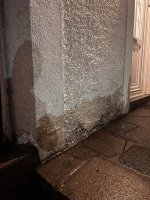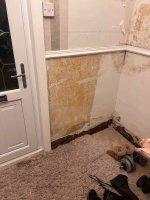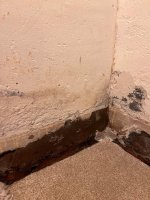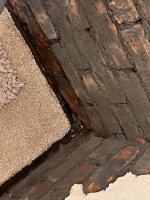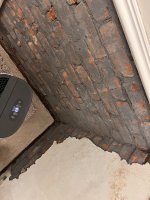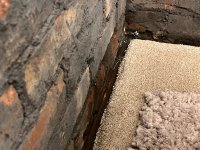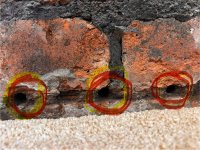Good Morning all
Apologies if this is in the wrong section - this is my first post.
I own a 1930's semi detached house in south wales. I have owned it for 6 years, and for those 6 years, we have had a minor damp issue in the entrance way to the house.
Just to give a bit of info, when we got the house, it had two air bricks fitted by the damp area, but also had the foam ball cavity wall insulation. I was told by a builder who was in quoting for some other work that we should not have air bricks as itll allow rain in and the CWI will transfer the water to the inside wall - so he quickly filled them in with mortar. We then, 5 years a go, had the CWI removed under the warranty as it shouldnt have been installed in the first place and the previous owner had essentially been mis sold it.
The exterior of the house is pebbledashed which, like every other house on the street, goes down to ground level. I am unsure what DPC is there as ive never seen under the pebbledash.
I had a damp expert in last week who advised no rising damp and couldnt really see any major concern - just left with some advice. We have a new roof and gutters so no issue there - but he thought maybe rain was bouncing off the path and hitting the house.
Ive added some photos. Please note, the one of the external wall, there is a shadow from the wall that makes it look worse than it is. There is green moss growing on the damp section.
I have re opened the air bricks, but when we have dry weather, plan to take them out and check the cavity for any debris.
You can see the internal wall, which I am in the process of hacking off. Also, along the lower course of bricks, there are holes every 8 cm in the mortar line, so not sure if someone has tried something before.
I also plan when doing the air brick, to remove about a meter heights worth of pebbledash render, as the lower 10/15cm by the front door has blown - which again, may be a reason the damp?
What I want to know is - what should I do to put it all right again. I am a complete novice, DIY-er, but am quite handy at these smaller jobs - I just lack the knowledge to know whats best and every google brings up something different.
What should I use to re render the small area of pebbledash I will remove?
What should I use to re render the internal wall? Ive been told I can just plasterboard it?
Should i insert dry rods, or a dpc cream?
Any advice is greatly appreciated - I just need a clear step by step guide on what to use
Many Thanks
Apologies if this is in the wrong section - this is my first post.
I own a 1930's semi detached house in south wales. I have owned it for 6 years, and for those 6 years, we have had a minor damp issue in the entrance way to the house.
Just to give a bit of info, when we got the house, it had two air bricks fitted by the damp area, but also had the foam ball cavity wall insulation. I was told by a builder who was in quoting for some other work that we should not have air bricks as itll allow rain in and the CWI will transfer the water to the inside wall - so he quickly filled them in with mortar. We then, 5 years a go, had the CWI removed under the warranty as it shouldnt have been installed in the first place and the previous owner had essentially been mis sold it.
The exterior of the house is pebbledashed which, like every other house on the street, goes down to ground level. I am unsure what DPC is there as ive never seen under the pebbledash.
I had a damp expert in last week who advised no rising damp and couldnt really see any major concern - just left with some advice. We have a new roof and gutters so no issue there - but he thought maybe rain was bouncing off the path and hitting the house.
Ive added some photos. Please note, the one of the external wall, there is a shadow from the wall that makes it look worse than it is. There is green moss growing on the damp section.
I have re opened the air bricks, but when we have dry weather, plan to take them out and check the cavity for any debris.
You can see the internal wall, which I am in the process of hacking off. Also, along the lower course of bricks, there are holes every 8 cm in the mortar line, so not sure if someone has tried something before.
I also plan when doing the air brick, to remove about a meter heights worth of pebbledash render, as the lower 10/15cm by the front door has blown - which again, may be a reason the damp?
What I want to know is - what should I do to put it all right again. I am a complete novice, DIY-er, but am quite handy at these smaller jobs - I just lack the knowledge to know whats best and every google brings up something different.
What should I use to re render the small area of pebbledash I will remove?
What should I use to re render the internal wall? Ive been told I can just plasterboard it?
Should i insert dry rods, or a dpc cream?
Any advice is greatly appreciated - I just need a clear step by step guide on what to use
Many Thanks


